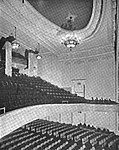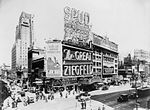Fulton Theatre
Buildings and structures demolished in 1982Demolished buildings and structures in ManhattanDemolished theatres in New York CityDinner theatreFormer Broadway theatres ... and 1 more
Theater District, Manhattan

The Fulton Theatre was a Broadway theatre located at 210 West 46th Street in Manhattan, New York City, that was opened in 1911. It was renamed the Helen Hayes Theatre in 1955. The theatre was demolished in 1982. Since the former Little Theatre became the current Helen Hayes Theatre, the Fulton Theatre is now sometimes referred to as the First Helen Hayes Theatre.
Excerpt from the Wikipedia article Fulton Theatre (License: CC BY-SA 3.0, Authors, Images).Fulton Theatre
Broadway, New York Manhattan
Geographical coordinates (GPS) Address Website Nearby Places Show on map
Geographical coordinates (GPS)
| Latitude | Longitude |
|---|---|
| N 40.7587 ° | E -73.9856 ° |
Address
New York Marriott Marquis (Marriott Marquis)
Broadway 1535
10019 New York, Manhattan
New York, United States
Open on Google Maps










